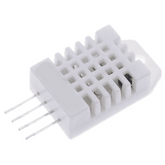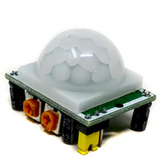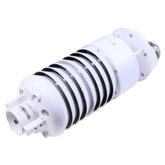What Are the Applications of IoT? - Complete Guide
Summary
Imagine a world where your refrigerator knows when you're running low on milk and automatically orders it for you, or your home adjusts its temperature before you even arrive. These are some of the use cases of Internet of Things.
Every day, billions of devices connect to the internet, collect data, and communicate with each other to make our lives easier, safer, and more efficient. From smart homes to industrial factories, IoT Applications are reshaping how we work, live, and interact with technology.

What is IoT or Internet of Things?
IoT refers to the vast network of physical devices, sensors, and software embedded with connectivity capabilities that enable them to collect, exchange, and act on data over the internet without human intervention. These devices range from simple sensors that measure temperature to complex systems managing entire manufacturing facilities.
The magic happens when billions of these devices communicate simultaneously:
- A smartwatch monitors your heart rate and sends that data to your phone
- Your phone analyzes the information and alerts you if something seems unusual
- Your fitness tracking app logs the data and displays trends over weeks and months
- This seamless interaction creates an intelligent ecosystem responding to real-world conditions in real time
IoT devices have the ability to gather massive amounts of data from physical environments. Unlike traditional computing where humans manually input information, IoT devices automatically sense their surroundings and report findings.
This continuous data stream enables systems to recognize patterns, predict problems, and optimize operations automatically.
What are the Key Components of an IoT System?
Learning about an IoT system means you must know how it’s components function. Every IoT ecosystem comprises several essential elements working in harmony.

Sensors and Actuators
Sensors are the eyes and ears of IoT systems. They detect physical phenomena and convert measurements into digital signals:
- Temperature sensors measure heat levels in environments and equipment
- Humidity sensors track moisture content in air or materials
- Pressure sensors detect force and stress on systems
- Motion sensors identify movement and presence
- Light sensors measure illumination levels
- Environmental sensors track air quality, pollution, and climate conditions
Actuators complement sensors by taking action based on collected data:
- Temperature control systems activate cooling or heating based on sensor readings
- Lock mechanisms engage or disengage in response to security alerts
- Pump systems turn on or off based on pressure or level measurements
- Lighting systems adjust brightness and color based on ambient conditions
Connectivity Layer
IoT devices need reliable communication pathways. Various technologies serve this purpose, each with distinct advantages:
| Technology | Range | Power Consumption | Use Case |
|---|---|---|---|
| WiFi | Moderate (100m) | High | Home networks, indoor IoT |
| Bluetooth | Short (10–100m) | Low | Wearables, personal devices |
| Cellular (4G/5G) | Wide area | Medium–High | Mobile IoT, vehicles |
| LoRaWAN | Long (10km+) | Very Low | Remote sensors, agriculture |
| NB-IoT | Wide area | Very Low | Long-range, low-power apps |
Data Processing and Storage
Raw sensor data becomes valuable only after analysis:
- Edge computing processes information at the device level, reducing latency and bandwidth requirements
- Cloud platforms store vast historical datasets, enabling pattern recognition and predictive analytics
- Fog computing layers between edge and cloud, providing localized processing power
- Local storage on devices preserves data when connectivity is unavailable
Applications and User Interfaces
The final layer involves software that interprets data and presents insights to users:
- Dashboards display real-time information from multiple sources
- Mobile apps enable remote control and monitoring
- Automated systems make decisions without human input
- Alert systems notify users of critical conditions or anomalies
Top Applications of IoT in Different Industries
IoT Applications span virtually every economic sector. Understanding these real-world implementations illustrates why IoT technology matters.
Healthcare and Medical Devices
IoT Applications in healthcare represent one of the most impactful deployments. The healthcare sector leverages IoT in multiple ways:

Patient Monitoring:
- Wearable devices continuously monitor vital signs (heart rate, blood pressure, oxygen levels)
- Remote patient monitoring allows doctors to track chronic disease progression from home
- Implanted medical devices send alerts when abnormalities are detected
- Hospital beds track patient movement and prevent falls through motion sensors
Equipment and Facility Management:
- Smart medical equipment tracks maintenance needs automatically
- Equipment failures are predicted before they occur, preventing critical outages
- Patient rooms adjust lighting and temperature based on occupancy and comfort preferences
- Medication dispensers remind patients when to take prescriptions and alert caregivers about missed doses
IoT enables healthcare providers to deliver personalized, proactive treatment rather than reactive interventions. Example of this application of IoT includes smartwatches that detect irregular heartbeats and alert users to seek immediate medical attention.
Manufacturing and Industry 4.0
Factory floors transformed by IoT Application concepts have become intelligent ecosystems. Modern manufacturing benefits from IoT through:

Production Optimization:
- Machines report their operational status continuously
- Production lines adjust parameters automatically based on product specifications
- Quality measurements trigger real-time process adjustments
- Predictive maintenance prevents breakdowns before they occur
Supply Chain Management:
- Asset tracking systems know the precise location and condition of inventory
- Supply chains coordinate seamlessly when IoT-connected equipment communicates directly with ordering systems
- Automated reordering occurs when stock levels drop below thresholds
- Shipping updates trigger automatically when products reach distribution centers
Energy and Safety:
- Energy consumption monitoring identifies inefficiencies and reduces operational costs
- Worker safety improves through wearable devices that detect hazardous conditions
- Safety equipment triggers alerts when proper protocols aren't followed
- Environmental sensors monitor factory conditions for compliance
Smart Home Technology
Your home becomes intelligent when applications of IoT connect various systems and devices:
Climate Control:
- Smart thermostats learn your preferences and adjust automatically
- Heating and cooling systems reduce energy bills through intelligent scheduling
- Humidity sensors maintain comfortable indoor environments
- Seasonal adjustments occur without manual intervention
Lighting and Security:
- Intelligent lighting adapts to your schedule and circadian rhythms
- Motion sensors activate lights only when rooms are occupied
- Security systems monitor entry points and alert you instantly about doors or windows opening unexpectedly
- Video doorbells let you see visitors remotely before answering the door
Appliances and Entertainment:
- Smart speakers respond to voice commands, controlling other devices
- Refrigerators track food inventory and suggest recipes based on available ingredients
- Washing machines notify you when cycles complete
- Entertainment systems recommend content based on viewing history
Transportation and Logistics
Connected vehicles represent a major IoT Application category with multiple benefits:
Fleet Management:
- Real-time tracking shows vehicle locations at any moment
- Driver behavior monitoring improves safety and reduces insurance costs
- Maintenance needs are detected before failures occur
- Fuel consumption is optimized through route planning
Autonomous and Connected Vehicles:
- Sensors enable vehicles to navigate safely without human input
- Vehicle-to-vehicle communication prevents collisions
- Traffic pattern recognition routes vehicles through less congested areas
- Autonomous delivery vehicles reduce transportation costs
Package Tracking:
- Shipments are tracked at every stage of transport
- Real-time location updates inform customers of delivery status
- Temperature-sensitive cargo maintains required conditions throughout transport
- Proof of delivery becomes automatic through GPS and sensors
Agriculture and Environmental Monitoring
Precision farming leverages IoT use cases to optimize crop yields while reducing resource consumption:
Crop Management:
- Soil moisture sensors indicate when irrigation is needed, preventing water waste
- Weather stations predict frost conditions, alerting farmers to activate protective measures
- Crop health monitoring sensors detect disease and pest infestations early
- Nutrient level sensors optimize fertilizer application
Livestock and Environmental:
- Livestock management systems track animal health, location, and behavior patterns
- Environmental sensors in forests monitor air quality and detect wildfires early
- Water quality sensors in rivers and oceans track pollution levels
- Climate condition measurements support sustainability initiatives
Retail and Customer Experience
Smart retail stores use IoT Applications to enhance shopping experiences:

Inventory and Restocking:
- Shelf sensors detect when products need restocking
- Automatic orders trigger when inventory levels drop below thresholds
- Stock accuracy improves through continuous monitoring
- Lost or misplaced item tracking reduces shrinkage
Customer Experience:
- Customer tracking systems analyze shopping patterns and optimize store layouts
- Smart fitting rooms provide size recommendations and suggest complementary items
- Personalized offers are sent to customers' smartphones based on store location
- Checkout-free systems use IoT sensors to eliminate waiting lines
Operations:
- Inventory management becomes automated through connected systems
- Price tags communicate with central systems for dynamic pricing
- Store cleanliness and maintenance needs are flagged automatically
- Energy usage is optimized based on store occupancy
How IoT is Used in Daily Life
Beyond industrial applications, applications of IoT influence personal routines in subtle but significant ways.
Morning Routine
Your smart home prepares you for the day ahead:
- Your alarm clock connects to your coffee maker—when you snooze, brewing delays automatically
- Your shower adjusts water temperature and flow based on your saved preferences
- Smart mirrors display weather forecasts, calendar appointments, and news headlines
- Lighting gradually brightens to simulate sunrise and improve wake-up quality
- Your bathroom scale sends weight data to your health tracking app
- Smart closet systems suggest outfit options based on weather and schedule
Commute
IoT devices enhance your journey to work or school:
- Your car starts warming up or cooling down before you reach it through remote connectivity
- Traffic monitoring integrates with your navigation app, suggesting the fastest route
- Your wearable device tracks steps and heart rate during your commute
- Vehicle sensors alert you to maintenance needs before problems develop
- Parking systems help you find available spaces quickly
- Public transportation apps provide real-time arrival information
Office Environment
Building IoT systems optimize workplace conditions:
- Sensors detect when your desk area is occupied, adjusting lighting and temperature accordingly
- Conference room booking systems integrate with calendars, preventing double-bookings
- Smart parking systems help you find available spaces quickly
- Air quality sensors maintain healthy indoor environments
- Occupancy data optimizes facility management and space utilization
- Energy systems reduce consumption during low-occupancy periods
Evening at Home
Your smart home system personalizes your arrival:
- Lights gradually brighten or dim based on sunset times
- Security systems arm automatically when the last person leaves
- Entertainment systems suggest content based on viewing history
- Thermostats adjust to your preferred evening temperature
- Kitchen appliances prepare for dinner preparation
- Door locks engage automatically for security
Health Tracking
Wearable devices continuously monitor your health metrics throughout the day:
- Sleep trackers record sleep patterns and provide improvement suggestions
- Fitness trackers remind you to move when sedentary for too long
- Heart rate monitors detect irregular patterns and alert you to concerns
- Calorie tracking integrates with nutrition apps for comprehensive health management
- Stress level measurements trigger relaxation reminders
- What is iot and its applications increasingly includes preventative health monitoring
What are the Future Trends in IoT Technology?
The IoT landscape continues evolving rapidly, with emerging technologies promising even more capability.
5G Networks
Fifth-generation wireless technology enables transformative IoT applications:
- Faster, lower-latency connections essential for real-time IoT applications
- Autonomous vehicles become practical at scale with improved network reliability
- Remote surgery and telemedicine benefit from reduced communication delays
- Industrial automation reaches new levels of precision and responsiveness
- Billions of simultaneous device connections become feasible
- Ultra-reliable, low-latency communications enable critical applications
Edge Computing Expansion
Processing power continues shifting from centralized cloud data centers:
- Devices handle more computation locally, reducing cloud dependency
- Faster response times improve user experiences
- Improved privacy since sensitive data stays on local systems
- Reduced bandwidth requirements decrease network congestion
- Offline functionality improves when cloud connectivity is unavailable
- Real-time decision-making becomes possible without cloud latency
Artificial Intelligence Integration
Machine learning algorithms embedded in IoT devices enable smarter decision-making:
- Devices won't simply report data—they'll analyze information independently
- Pattern recognition improves over time as systems learn from historical data
- Predictive maintenance becomes standard across industries
- Anomaly detection identifies problems before they become critical
- Autonomous systems make complex decisions without human intervention
- Natural language processing enables more intuitive device interaction
Enhanced Security
As IoT adoption accelerates, security improvements become critical:
- Blockchain technology secures IoT transactions and data exchanges
- Quantum-resistant encryption protects communications from emerging computing threats
- Standardized security protocols replace current fragmented approaches
- Multi-factor authentication prevents unauthorized device access
- Secure boot processes prevent firmware tampering
- Zero-trust security models verify all device communications
Interoperability Standards
Currently, many IoT ecosystems operate in isolation:
- Standardized communication protocols enable seamless device interaction
- Devices from different manufacturers work together without proprietary adapters
- Universal platforms simplify IoT deployment and management
- Faster innovation accelerates when developers build on common standards
- User experiences improve through simplified setup and integration
- Market competition drives better features and lower costs
Sustainability Focus
Energy-efficient IoT devices become standard as environmental concerns grow:
- Solar-powered sensors enable truly wireless deployments
- Battery technology improvements extend device operating life
- Low-power protocols reduce energy consumption dramatically
- Environmental impact of IoT manufacturing receives increased attention
- Circular economy principles guide device design and disposal
- What is iot and its applications increasingly involves reducing environmental impact while improving efficiency
Conclusion
The Internet of Things has evolved from a futuristic concept into a practical reality transforming every aspect of modern life. From healthcare providers delivering personalized treatment to manufacturers optimizing production lines, IoT Applications deliver tangible benefits.
As technology advances and connectivity improves, IoT's impact will only expand. Whether through improved efficiency, enhanced safety, or better decision-making, IoT enables devices to work intelligently on our behalf, creating a more connected and responsive world.















